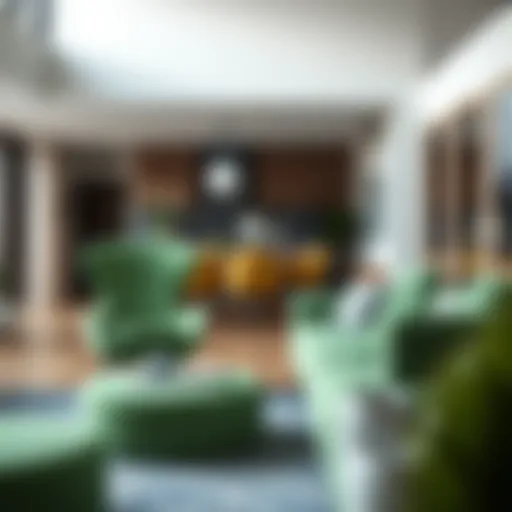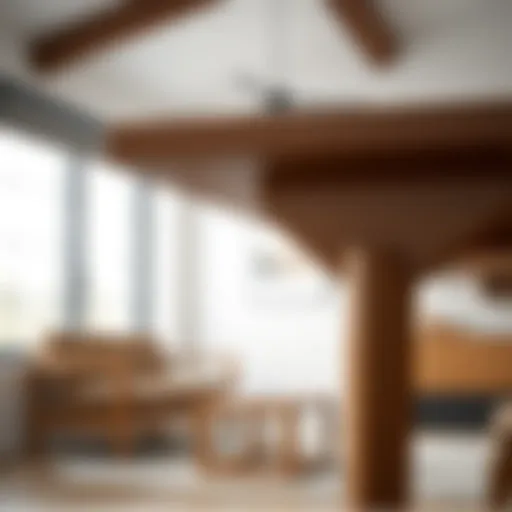The Art of Bedroom Screen Dividers: Enhance Space
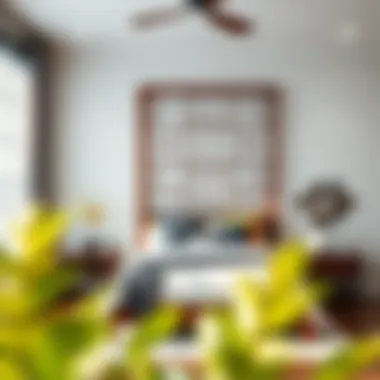
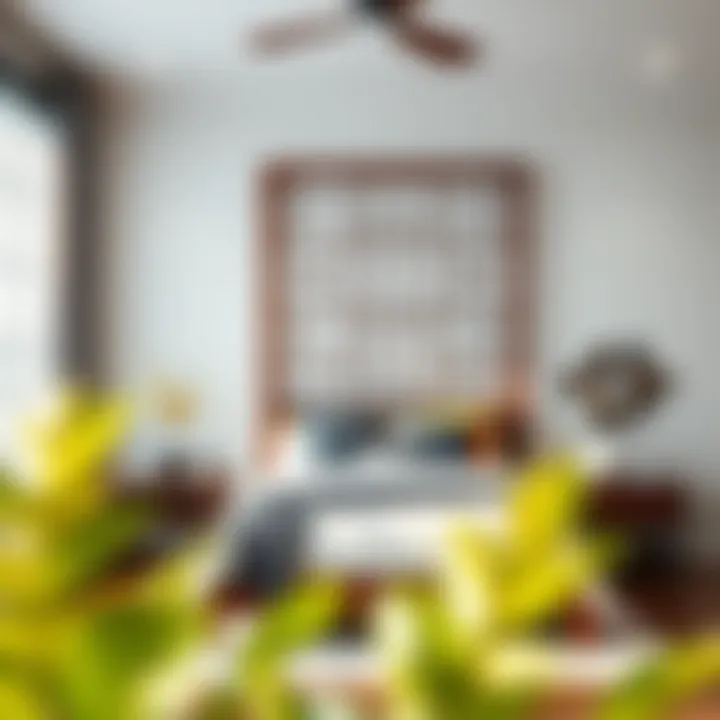
Intro
In modern homes, the way we use space can often feel like a whirlwind tussle between functionality and aesthetics. One standout element that helps strike this balance is the bedroom screen divider. These versatile pieces not only transform the look of a room, they serve essential roles in dividing spaces, enhancing privacy, and adding a touch of flair to your decor. The ever-evolving designs and materials available allow homeowners to express their individual style while maximizing the utility of their bedrooms.
Perhaps you've noticed how a simple screen can turn an otherwise bland corner into a cozy little reading nook? Or how it can create a perfect spot for a home office, tucked away yet still part of the room? These dividers offer endless possibilities for reconfiguring your environment without a full renovation.
As we delve deeper into the world of bedroom screen dividers, we'll explore various styles and current design trends, ensuring that whether you're a homeowner, designer, or a DIY enthusiast, you find something to inspire and inform your choices.
So, how do we take these functional decor items from simply being dividers to becoming show-stoppers within our living spaces? Let's embark on this exploration together.
Intro to Bedroom Screen Dividers
In contemporary living, where space often feels like a precious commodity, the ability to enhance both functionality and aesthetics is paramount. This article will take a closer look at bedroom screen dividers, which serve not only as decorative elements but also as practical solutions for partitioning areas in a room. Homeowners, designers, and DIY enthusiasts alike can benefit from understanding the various aspects of screen dividers, including how to choose the right one that complements personal style and maximizes space utility.
Screen dividers come in a variety of shapes, sizes, and materials, allowing individuals to create defined sections within their bedrooms—be it for privacy, storage, or simply to delineate different functions within a singular space. They transform the environment, giving character to spaces that would otherwise feel cramped and disorganized. The strategic use of these separators can also facilitate smoother traffic flow and interaction in shared areas, presenting opportunities for both intimate moments and open engagement with family or friends.
Furthermore, the installation of screen dividers can contribute significantly to personal well-being. They can provide a sense of sanctuary within a multi-functional space, offering a retreat from the distractions of everyday life. Considerations such as size, style, and material are essential when determining the most suitable divider for a given space, ensuring that it not only serves a purpose but also aligns with the intended design aesthetic. As we explore these factors more deeply throughout this article, significantly enriching our understanding of bedroom screen dividers will become apparent.
Definition and Purpose
Screen dividers, sometimes referred to as room dividers or privacy screens, are versatile tools used to partition spaces within a room. While their primary function is to create separation and privacy, they also play an essential role in enhancing the overall visual appeal of a space.
These dividers can vary from permanent fixtures to more flexible options that can be adjusted based on the homeowner's evolving needs. They make it significantly easier to create private nooks for reading, dressing, or simply unwinding, allowing one to have their own space without the need for extensive renovations.
Historical Context
The concept of room dividers is not new; in fact, it has roots dating back thousands of years. In ancient China, elaborate folding screens known as "screen panels" were utilized to separate spaces and serve as decorative elements in homes and palaces alike. Similarly, in medieval Europe, screens were essential in keeping private areas concealed and warming up hallways in grand old castles.
As time progressed, the design and material used in dividers evolved, reflecting cultural shifts and advancements in craftsmanship. From ornately carved wood to minimalist metal frames, dividers adapted to the changing tastes of society. They transitioned from purely functional objects to artful statements that contribute to interior design aesthetics, demonstrating their enduring relevance in home decor.
Aesthetic Considerations
Aesthetic considerations play a pivotal role when it comes to integrating bedroom screen dividers into a living space. First and foremost, these elements are not just practical installations but also significant contributors to the overall ambiance of a room. The right screen divider can elevate a space, reflecting the homeowner's style while serving functional purposes. It’s like dressing up a room; the right attire can make all the difference.
Complementing Interior Styles
When selecting a screen divider, the goal should always be to harmonize with the current interior design. Whether your bedroom boasts a modern minimalist, a cozy farmhouse, or a bohemian vibe, there’s a screen that can complement it beautifully. For instance, sleek metal frames with glass accents can enhance a contemporary design, giving it a clean, sophisticated edge.
Conversely, a rustic wooden divider with carvings may bring warmth and charm to a traditional setting. Textures and finishes also matter immensely; a matte-black divider can project an industrial feel, while a soft fabric could lend a romantic touch. The choices you make are akin to how one accessorizes an outfit—what works best depends on what you’re working with and what you aim to achieve.
Color and Pattern Choices
Colors and patterns are where the fun begins. A bold color can serve as an impactful focal point in a neutral room, drawing the eye and setting the tone. You might consider using a vibrant teal or deep maroon for added drama. Patterns can do just as much: a geometric print could inject a sense of modernity, while florals might speak to a classic sensibility.
When thinking about color schemes, it's wise to take cues from existing elements in the room. A divider can act as a bridge to tie together various hues or tones, making the entire space feel cohesive. The balance between bold and subtle can be dance; strike the right note, and your divider can become a piece of art.
Creating Visual Interest
So how do you make a screen divider not just functional but visually captivating? Think of it as a canvas. Layering textures and integrating multi-dimensional elements can transform a simple divider into an eye-catching showcase.
Consider introducing dividers that feature cut-outs or intricate lattice work. These designs allow light to play through, casting interesting shadows and patterns that shift throughout the day. You can also hang decor from the divider—like a string of fairy lights or hanging plants—which adds further depth and personality.
In essence, a bedroom screen divider serves dual purposes: it partitions space for privacy while also standing as a creative statement in the interior design narrative. This layering of purposes is what makes selecting the right screen divider a crucial step in space enhancement.
"Your living space should tell the story of who you are, and be a collection of what you love."
Integrating a screen divider is akin to weaving a narrative into your room—a story told through aesthetics that resonates with visitors and occupants alike.
Functional Benefits


The movement towards open-concept living spaces has made the role of bedroom screen dividers increasingly significant. These dividers are not just aesthetic choices; they serve practical functions that can enhance both space and livability, making them a must-have in modern interior design. Let's explore the diverse set of advantages that come with utilizing screen dividers in your bedroom setting.
Space Definition and Privacy
Screen dividers are incredibly effective at defining space within a room. In a tight sanctuary, they help demarcate areas for sleeping, dressing, or working without the need for permanent walls. This becomes especially useful in studio apartments or multifunctional rooms where boundaries may often feel blurred. Positioning a divider can create a cozy nook for reading or a distinct area for relaxation, catering to a varied lifestyle.
Moreover, these dividers significantly enhance privacy. Whether you live with roommates or have a larger family, having a dedicated space that's separated can be invaluable. For instance, a soft fabric divider not only partitions the area but can also absorb sound, shielding intimate moments or personal time from being interrupted. It’s somewhat like a hug for your room – warm and protective.
Flexible Room Configurations
One of the most liberating aspects of screen dividers is their reconfigurability. Unlike built-in walls, these movable barriers can adapt alongside your needs and preferences. Need more room for entertaining one evening? You can swiftly shift or fold your dividers to open up your space.
The flexibility also extends to the various styles available, which cater to different tastes and functions. From a minimalist metal screen that offers a sleek look, to a bohemian fabric divider adorned with patterns, each choice can reflect your personality while serving practical purposes. Furthermore, when hosting guests, you could create a temporary guest area that offers them privacy without the permanent commitment of redesigning.
Concealing Clutter
Another undeniable benefit of screen dividers is their ability to cleverly conceal clutter or less appealing areas of your room. Nobody enjoys seeing messy clothes or an overflowing laundry basket when they enter their personal space. A well-placed divider can act as a fashionable shield, promoting a manicured and tidy atmosphere.
You can even choose to create a mini storage area behind your divider, turning an unsightly part of the room into a functional zone.
Here's how you can use dividers effectively:
- Soft fabrics for a warm, cozy feel while hiding away elements that disrupt your aesthetic.
- Wooden or metal screens to juxtapose with your decor and still mask those everyday essentials.
"Creating zones with these dividers allows for both utility and style, a true win-win in small-space living."
Whether you’re opting for curated decor or just striving to keep chaos under wraps, the functional benefits of bedroom screen dividers elevate the livability of your personal oasis.
Materials Used in Screen Dividers
Selecting the right materials for screen dividers is crucial in both functionality and aesthetic appeal. The materials chosen not only determine the durability and practicality of the divider but also convey a certain style and feel within the room. Understanding the different types of materials allows homeowners, designers, and DIY enthusiasts to make informed choices that align with their design objectives and needs. The choice of material can affect how much privacy a screen offers, how well it blends with existing decor, and how easy it is to maintain.
Wooden Dividers
Wooden dividers often serve as a quintessential choice due to their warmth and timeless quality. Available in various types, such as oak, pine, or walnut, wooden screens can cater to both traditional and contemporary styles. One notable quality of wood is its ability to absorb sound, making it a good option for improving privacy while also minimizing noise.
When considering wooden dividers, think about:
- Finish and Stain: Different finishes can create striking contrasts or harmonize with existing furnishings.
- Weight: Heavier wooden dividers may require more support and might be less flexible when it comes to moving or reconfiguring spaces.
- Grain Patterns: Unique grain textures can introduce visual interest, enhancing the overall design.
In terms of care, generally, a light dusting with a microfiber cloth or occasional polishing can keep your wooden dividers looking splendid.
Fabric and Soft Screens
Fabric and soft screens offer a more dynamic approach to dividers, often bringing in color and texture while seamlessly blending into various themes. From sheer fabrics that offer a gentle division to heavy drapes that provide substantial privacy, fabric screens cater to a range of preferences.
Considerations for using fabric include:
- Material Type: Think about cotton, linen, or synthetic options depending on the desired look and durability. Some fabrics might fade in sunlight, while others can be more resistant.
- Design Flexibility: Fabrics can easily be replaced or altered, allowing for quick style updates.
- Ease of Cleaning: Many fabric dividers can be machine-washed or dry-cleaned, but some may need more specialized care.
In short, fabric dividers are perfect for those inclined towards a softer, cozier aesthetic.
Metal and Glass Options
Metal and glass provide a sleek, modern feel, fit for contemporary interior designs. Metal dividers are often seen in minimalist spaces and can add structural integrity, while glass dividers can create a sense of openness, allowing light to flow while still providing a defined space.
Here are a few points on metal and glass dividers:
- Durability: Metal is typically long-lasting and resistant to wear. Glass, particularly tempered glass, is also relatively strong and safe.
- Design Impact: Both materials can bring an industrial or modern flair to a space. Frosted or etched glass can soften the harshness while still maintaining that sleek look.
- Installation Considerations: Metal and glass may require professional installation, especially glass screens that need proper support.
"Choosing the right material for your screen divider is as important as selecting the right furniture; it sets the tone for the entire room."
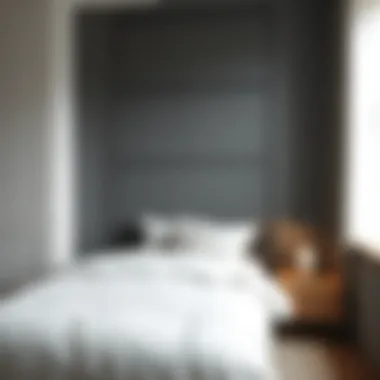
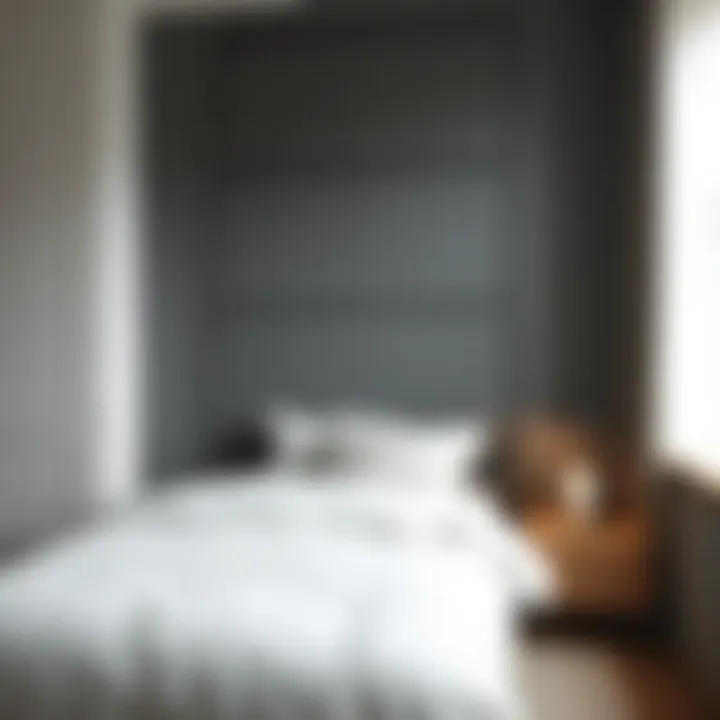
To learn more about the aesthetic functions of furniture materials, you can check out resources on wikipedia.com or britannica.com.
Styles of Bedroom Screen Dividers
When it comes to bedroom screen dividers, style is not just about aesthetics; it serves practical purposes that connect deeply with personal expression and functionality. The array of styles available means that every individual can find something that resonates with their taste while also fulfilling specific needs in their space. Understanding the different styles available will aid homeowners, designers, and DIY enthusiasts in selecting the perfect divider to reinforce the character of the room, making it a multifaceted tool in the realm of interior design.
Traditional vs. Modern Designs
Traditional designs often reflect ornate craftsmanship, showcasing intricate woodwork, rich fabrics, and motifs that hark back to historical aesthetics. These dividers often draw inspiration from different cultural backgrounds, whether it’s Japanese shoji screens or European folding screens that feature elaborate paintings or carvings. Such elements foster warmth and a sense of history, making them perfect for those who appreciate a classic vibe.
In contrast, modern designs embrace minimalism and clean lines, focusing on functionality and simplicity. Instead of heavy materials, you might find sleek metal frames or tempered glass panels that provide a sense of openness even while dividing space. This makes them particularly appealing in contemporary homes where space is at a premium.
When choosing between traditional and modern styles, consider the existing decor of your bedroom. For instance:
- Traditional Designs: Look for rich wood finishes or elegant fabric options. These can add a timeless feel to your sanctuary.
- Modern Designs: Opt for transparent materials to maintain a light atmosphere without sacrificing privacy.
Contemporary Trends
The world of interior design is always evolving, and bedroom screen dividers are no exception. Contemporary trends emphasize sustainability, with eco-friendly materials and innovative designs leading the way. Bamboo dividers or recycled metal frames are becoming increasingly popular as people seek to reduce their environmental footprint.
Another trend gaining traction is the use of multi-functional screen dividers. These dividers do not only separate spaces; they can also serve other purposes. For instance, certain designs double as bookshelves or have built-in storage options. In an age where multifunctionality is paramount, such trends resonate well with homeowners who want to maximize the use of their space.
Creative Usage Ideas:
- Use a divider with shelving to display plants or photos, adding a personalized touch.
- Consider fabric dividers that can be easily reconfigured or updated to reflect seasonal changes or personal mood shifts.
Custom and DIY Dividers
For those with a creative streak, the world of custom and DIY dividers is an enticing one. Crafting your own screen divider can be an immensely satisfying project that not only reflects your individual style but also allows for a personal touch. Many people opt for DIY projects using repurposed materials, like wooden pallets or old doors, giving new life to items that may otherwise have been discarded.
When embarking on a DIY divider project, consider these key aspects:
- Materials: Choose wisely based on desired durability and aesthetic. Wood, fabric, or even a combination can yield fantastic results.
- Design: Sketch out your ideas beforehand; consider how it will function in the space as well as how it will look.
- Finishes: Play with paints and stains to achieve a look that matches or contrasts with your current decor.
Creating your own divider allows for a freedom that store-bought options simply can't provide. It’s an opportunity to inject your personality into your living space; the possibilities are endless.
"A well-placed screen divider can transform your private space into something that feels more personal and inviting. It’s all about how you style it."
In summation, the styles of bedroom screen dividers cater to a multitude of tastes and functional needs. Whether you gravitate toward traditional or modern designs, are inspired by contemporary trends, or choose the DIY route, the screening options available will culminate in a unique expression of your home's persona.
Placement Strategies
When it comes to bedroom screen dividers, placement is key. Thoughtful positioning can amplify both the aesthetic and functional aspects of your space. Done right, a screen divider can redefine your bedroom, turning a simple room into an oasis of privacy and style. Here, we delve deep into how to find the right spot for your divider and ensure that it works harmoniously with the flow of movement in your bedroom.
Finding the Right Location
Selecting the ideal location for your screen divider involves more than just a guess; it’s about truly understanding your space and what you want to achieve. Here are a few tips to guide you:
- Assess Your Room Layout: Consider the current layout of your bedroom. Is there a particular area that feels cramped or lacks definition? A screen may serve well in these spots, carving out a nook for relaxation, or adding a touch of elegance to an otherwise dull corner.
- Define Functionality: Ask yourself what purpose you want the divider to serve. Is it for privacy? Creating distinct spaces? Or merely for decoration? Identifying the function can lead you to the best placement.
- Natural Light Consideration: Take note of windows and lighting. Placing a divider where it allows light to flow can enhance the ambiance without blocking those sunny rays. Remember, you want to feel comfortable and airy, not shut-in.
- Visual Balance: ensure that the divider complements the room's visual equilibrium. Too large a divider might overwhelm a small room, while too small might get lost in a spacious one. Find that sweet spot where the divider enhances the overall aesthetics.
Considerations for Traffic Flow
Just as important as placement is understanding how people will move around your space. Here are a few essential things to ponder with respect to traffic flow:
- Keep Pathways Clear: Avoid placing screen dividers in a way that obstructs key walking areas. A well-placed divider should direct movement rather than hinder it. Think about where you often walk and allow space for that.
- Create Zones: If your bedroom doubles as a workspace or lounge, effectively using dividers can help in zoning. They can guide how one moves from the bed to a work area while keeping everything organized. Consider this when deciding where to put them.
- Test Different Arrangements: Sometimes, your first hunch might not be right! Don’t hesitate to experiment with the location of your divider. Move it around a few times before deciding on a final position. This trial and error can uncover the most optimal spot for functionality and flow.
"A thoughtful placement strategy can transform a simple divider from an afterthought into a stunning centerpiece that brings joy and organization to your everyday life."
In summary, placement strategies are pivotal for harnessing the true potential of bedroom screen dividers. By considering both the right location and the flow of traffic, you can amplify the functionality and beauty of your space significantly.
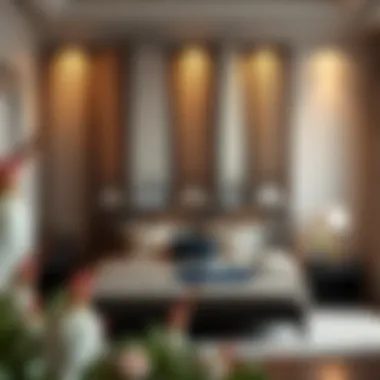
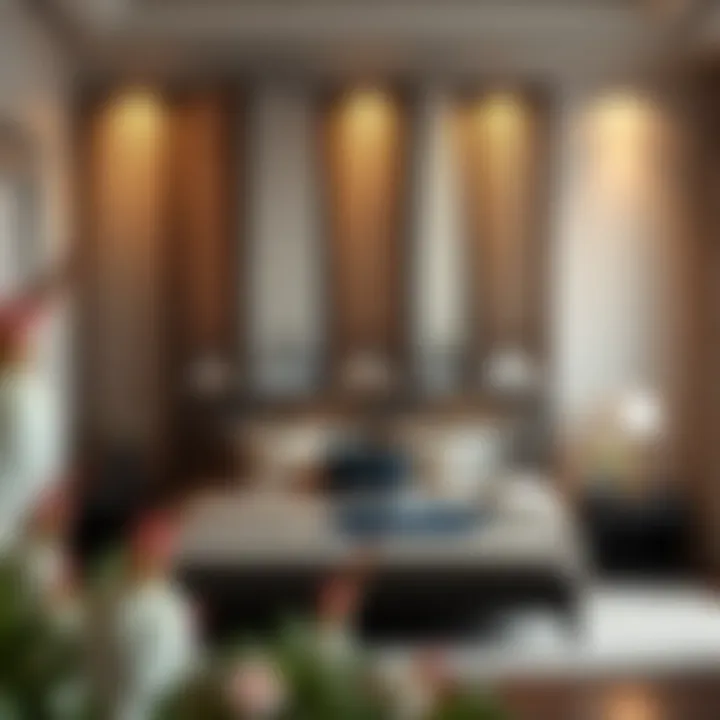
Maintenance and Care
Maintaining bedroom screen dividers is a crucial aspect that directly affects their longevity and performance within your living space. Just like any other piece of furniture, these dividers require regular attention to keep them looking good and functioning well. Not only does this care preserve their aesthetics, but it also ensures they fulfill their practical roles, such as providing privacy and creating a defined space.
Cleaning Different Material Types
The cleaning methods for screen dividers can vary significantly based on the material they are made of. It's essential to understand how to treat each type of material to avoid damaging it. Here are some common materials used in screen dividers and tips for cleaning them:
- Wooden Dividers: These can accumulate dust and grime over time. A soft, damp cloth should usually do the trick. Be careful not to soak the wood; it can warp. For stubborn stains, a mild wood cleaner can be useful, yet it’s wise to test any product on a hidden area first.
- Fabric Screens: If you have soft screens made from fabric, these might require a little more effort. Vacuum gently with a brush attachment to remove dust. If stains appear, spot clean them with soap and water or a fabric cleaner. When in doubt, a professional cleaning service might be best to avoid any mishaps.
- Metal and Glass Options: These materials generally require less upkeep. For glass, a standard window cleaner can leave it sparkling. Metals may need dusting, but also consider using a polish if they start looking dull. Always check that any cleaner is appropriate for the specific finish of your screen.
Remember that when cleaning, less is often more. For screen dividers, a gentle touch can go a long way in preserving their beauty.
Preventing Wear and Tear
Preventing wear and tear on your bedroom screen dividers is not just about cleaning; it also involves mindful placement and use. Here are a few strategies to help extend their lifespan:
- Choose Appropriate Locations: Place dividers where they won’t be frequently bumped into or exposed to direct sunlight for long periods, which could fade colors and materials. Avoid areas that endure a lot of traffic.
- Use Proper Handling Techniques: When moving screen dividers, you want to lift rather than drag them. This approach lessens the chance of damaging the hinges or joints, especially in foldable designs.
- Regular Inspections: Just like a car needs a check-up, so do your dividers. Take a moment every few months to ensure there are no loose parts, scratches, or signs of wear that could escalate into bigger problems later.
“An ounce of prevention is worth a pound of cure.”
Being proactive about care can save homeowners and designers alike a lot of time and money. Maintaining screen dividers not only keeps the space looking pristine but also retains their functional benefits for years to come.
Market Trends and Innovations
As we look into the evolving landscape of bedroom screen dividers, it becomes clear that trends and innovations play a crucial role in shaping both the design and utility of these fixtures. Their ability to adapt to modern living environments is not just a matter of style or individual preference; it’s about meeting the practical needs of homeowners, designers, and DIY enthusiasts alike. Understanding these trends allows stakeholders to make informed choices, ensuring both aesthetic appeal and functionality are achieved in the living space.
Sustainable Options in Screen Dividers
Sustainability is increasingly becoming a cornerstone of modern design principles. The focus on eco-friendly materials and products has gained traction due to growing concerns about environmental impact. Homeowners today are looking beyond mere aesthetics—they want screen dividers that contribute positively to the planet.
Some sustainable options in screen dividers include:
- Recycled Materials: Dividers made from recycled wood or fabric reduce waste in landfills and provide a unique character.
- Bamboo Dividers: Bamboo is a fast-growing plant that is highly renewable, making it an attractive option for conscientious buyers.
- Natural Finishes: Many manufacturers now offer dividers treated with natural oils or water-based finishes, avoiding harmful chemicals.
Opting for these sustainable choices not only enhances the eco-friendliness of the home but also adds a story to the space. Each divider can act as a conversation starter, bringing attention to eco-consciousness and individual taste. Ultimately, sustainable options in bedroom screen dividers not only fulfill functionality but also resonate with a growing demographic that values environmental responsibility.
Technological Advancements
Technology has made great strides in recent years, and the realm of bedroom screen dividers is not left untouched. Innovations are reshaping the way these dividers function and are perceived in interior design. For instance, smart screens are emerging as a notable feature. These screens can double as interactive surfaces, transforming how individuals interact with the space around them.
Here are some key technological aspects to consider:
- Smart Dividers: Screen dividers with integrated technology that allows features such as adjustable transparency, integrated LED lighting, and even sound absorption capabilities.
- Modular Designs: Advances in design software allow for customizable, modular screen dividers that can easily adapt to changing spaces. Homeowners can modify or expand their layout without the need for significant renovations.
- Sound Management: Modern materials are engineered not only for aesthetic purposes but also for their acoustic properties, helping to reduce noise in shared environments.
The integration of technology into screen dividers enhances both their functionality and aesthetic value, making them a versatile asset in any living environment.
As we explore these avenues, it becomes evident that market trends and innovations do not merely dictate what is 'in style' but rather enable a richer interaction between space, functionality, and individuality. Keeping an eye on these trends ensures that homeowners, designers, and DIY enthusiasts stay ahead of the game, creating spaces that are both visually appealing and practical in an ever-evolving world.
Culmination
When it comes to home design, bedroom screen dividers are more than just decorative pieces; they’re pivotal to enhancing both aesthetics and practical functionality. In this article, we explored the incredible versatility of screen dividers, peeling back layers to reveal how they redefine spaces. From delineating areas for privacy to providing a canvas for personal expression, these dividers embody both form and function in one neat package.
Summarizing the Impact of Screen Dividers
The impact of bedroom screen dividers can hardly be overstated. They serve crucial roles in creating a sense of separation within open spaces. By doing so, they allow for a private nook in a shared environment, which can be especially beneficial in urban living where space is often at a premium. Moreover, screen dividers can add variety in texture and color, making the room feel more dynamic and inviting.
- Visual Appeal: A well-placed divider can draw the eye and act as a focal point, breaking the monotony of flat walls.
- Space Optimization: These dividers can functionally transform a bedroom into a multi-purpose area, such as integrating a home office or an art corner without the expense of setting up permanent walls.
- Cultural Reflection: Different styles offer insights into varying design philosophies, reflecting broader trends in culture and innovation.
It’s clear that screen dividers are not merely an afterthought but rather a thoughtful consideration in contemporary design.
Future of Bedroom Screen Dividers
Looking ahead, the future of bedroom screen dividers seems promising. As more individuals embrace minimalistic lifestyles and sustainable living, there’s a growing trend toward eco-friendly materials. This includes the use of reclaimed wood or sustainable fabrics that not only enhance beauty but also lessen environmental impact. Manufacturers are also exploring innovative designs that blend technology with artistry, incorporating smart features for added convenience.
A few aspects to watch in the coming years might include:
- Integration with Smart Home Systems: Imagine dividers that can change opacity or color at the touch of a button, allowing for instant reconfiguration of the space.
- Customization Options: More brands are likely to offer personalized designs that cater to the unique tastes and needs of homeowners, from colors to materials, offering uniqueness to each set up.
- Affordable Artistry: With the rise of DIY culture, expect to see instructions and kits that empower homeowners to craft their own personalized dividers at home.



